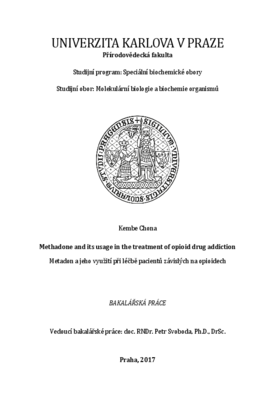Methadone and its usage in treatment of opioid drug addiction
Methadon a jeho využití při léčbě pacientů závislých na opioidech
bachelor thesis (DEFENDED)

View/
Permanent link
http://hdl.handle.net/20.500.11956/87577Identifiers
Study Information System: 186751
Collections
- Kvalifikační práce [20088]
Author
Advisor
Referee
Hejnová, Lucie
Faculty / Institute
Faculty of Science
Discipline
Molecular Biology and Biochemistry of Organisms
Department
Department of Cell Biology
Date of defense
2. 6. 2017
Publisher
Univerzita Karlova, Přírodovědecká fakultaLanguage
English
Grade
Very good
Keywords (Czech)
metadon, opioidní receptory, heroin, substituční terapieKeywords (English)
methadone, opioid receptors, heroin, maintanance treatmentMetadon, syntetický opioid vytvořený ve 40. Letech, je silným agonistou mu opioidních receptorů. Opioidní receptory jsou podskupinou super-rodiny GPCR. Jejich nejdůležitější funkcí je inhibice nervových přenosů pomocí regulace activity iontových kanálů a efektorových proteinů. µ-opioidní receptory jsou hlavním místem působení heroinu, metadonu a jiných klasických opioidních agonistů. Díky distribuci opioidních receptorů v centrální nervové soustavě a periferních tkáních je metadon schopen působit na širokou škálu funkcí v organismu. Metadon vyvolává mnoho s běžných účinků opioidů jako jsou analgeze, seadace, deprese dýchacího centra, euforie aj. I přes původní záměr syntézy metadonu jakožto analgetika byly velmi brzy objeveny jeho vlastnosti použitelné pro jiné účely. Výzkum metadonové substituční terapie byl započat v roce 1963 profesorem Vincentem P. Dolem a jeho týmem. Velice rychle se prokázalo, že substituční terapie poskytuje z dlouhodobého hlediska zdaleka největší úspěchy rehabilitace pacientů závislých na opiátech. Díky vysoké biodostupnosti, relativní účinnosti a dlouhému poločasu rozpadu je metadon nejvíce využívanou látkou pro substituční terapii. Metadon podávaný v přiměřených dávkách vyvolává pouze slabé nežádoucí účinky, a zároveň je schopen znovu nastolit fyziologickou rovnováhu...
Methadone, a synthetic opioid created in the 1940s is a potent mu opioid receptor agonist. Opioid receptors form a sub-group of the GPCR super-family. Their most significant role is the inhibition of neural pathways by regulating the activity of ionic channels and effector proteins. µ-opioid receptors are the site of action of heroin, methadone and other classical opioid agonists. Due to the opioid receptors distribution in both the central nervous system and peripheral tissues, methadone affects a wide variety of functions in the organism. Methadone induces many of the effects of classical opioids including analgesia, respiratory suppression, sedation, euphoria. While originally being developed as an analgesic it had soon shown potential for other therapeutic methods. Methadone maintenance therapy was introduced in 1963, by professor Vincent P. Dole and his team. It quickly became clear that methadone substitution therapy is indeed very effective and shows the highest ability to retain patients. Thanks to its high oral bioavailability, higher intrinsic efficacy and long terminal half-life methadone is the first choice drug for opioid substitution therapy. Methadone, used in appropriate doses produces only mild adverse effects and has the ability to normalize physiological homeostasis disrupted by...
